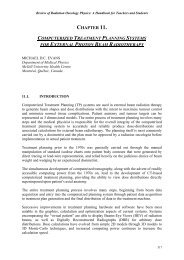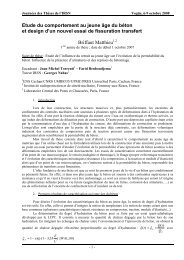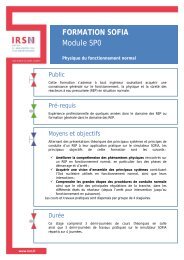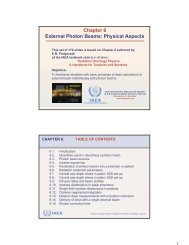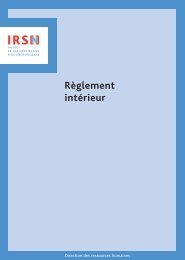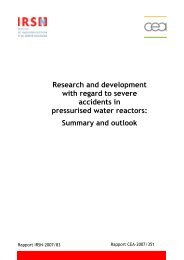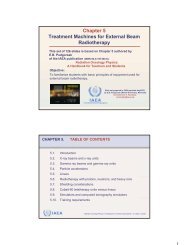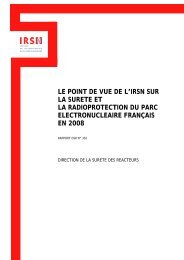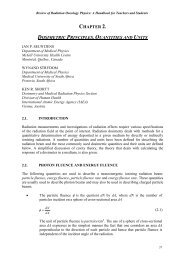Guide d'aide à la décision pour la gestion du milieu agricole ... - IRSN
Guide d'aide à la décision pour la gestion du milieu agricole ... - IRSN
Guide d'aide à la décision pour la gestion du milieu agricole ... - IRSN
You also want an ePaper? Increase the reach of your titles
YUMPU automatically turns print PDFs into web optimized ePapers that Google loves.
Ca<strong>la</strong>is. Le taux d’irrigation est plutôt faible dans <strong>la</strong> région Nord-Pas-de-Ca<strong>la</strong>is (8% <strong>à</strong> 25 %). Il est moyen en Picardie (42% <strong>à</strong>51%) et dans <strong>la</strong> Marne (36%) et très élevé dans <strong>la</strong> région Centre et dans l’Aube (supérieur <strong>à</strong> 80%). A l'exception despommes de terre de primeur, commercialisées dès <strong>la</strong> récolte (avant le 31 juillet), tous les autres types sont susceptiblesd'être conservés pendant une période pouvant aller de quelques semaines <strong>à</strong> plus de 8 <strong>à</strong> 10 mois.QUELQUES CRITERES TECHNIQUES CONCERNANT LES GRANDES CULTURES EN FRANCEREPERES TEMPORELS SUR LA CONDUITE DES CULTURESPréparation <strong>du</strong> solLabour ou travail de sol simplifié (avant le semis)SemisCéréales <strong>à</strong> paille (sauf orge et avoine de printemps J F M A M J J A S O N DOrge et avoine de printemps, maïs, pois, féverole,tournesol, sojaJ F M A M J J A S O N DPommes de terre J F M A M J J A S O N DColza J F M A M J J A S O N DBetterave J F M A M J J A S O N DRécolteCéréales <strong>à</strong> paille (blé, orge, etc.), colza J F M A M J J A S O N DMaïs ensi<strong>la</strong>ge, tournesol J F M A M J J A S O N DMaïs grain, soja J F M A M J J A S O N DPois et féverole J F M A M J J A S O N DPommes de terre primeur J F M A M J J A S O N DPommes de terre de conservation J F M A M J J A S O N DBetteraves J F M A M J J A S O N DORDRES DE GRANDEUR DES PRODUCTIONS DES CULTURESCulturesBléOrgeRendements60 <strong>à</strong> 120 q/ha (entre 13% et 16% d'humidité) <strong>à</strong> 75-78 kg/hl5 <strong>à</strong> 8 t MS/ha de paille (9 <strong>à</strong> 10% d'humidité) <strong>à</strong> 100-150 kg/m 360 <strong>à</strong> 80 q/ha (entre 13% et 16% d'humidité) <strong>à</strong> 60-71 kg/hl4 <strong>à</strong> 5 t MS/ha de paille (9 <strong>à</strong> 10% d'humidité) <strong>à</strong> 100-150 kg/m 3Maïs grain 70-110 q/ha (14 <strong>à</strong> 15% après séchage, <strong>la</strong> récolte étant effectuée <strong>à</strong> 25%)Maïs ensi<strong>la</strong>ge (p<strong>la</strong>nte entière)Pois et FéverolePomme de terre conso et féculerieColzaTournesolSoja*MS : matière sèche70-76 kg/hl12 <strong>à</strong> 18 t MS*/ha (<strong>à</strong> 30 % d'humidité environ)35-50 q/ha (14 <strong>à</strong> 15% d’humidité) <strong>à</strong> 75-84 kg/hl4-5 t MS/ha de paille (9 <strong>à</strong> 10% d’humidité) <strong>à</strong> 100-150 kg/m 335-55 t/ha (brut) <strong>à</strong> 90 kg/hl20 <strong>à</strong> 50 q/ha (entre 8% et 10% d’humidité)10 <strong>à</strong> 40 q/ha (entre 7% et 9% d’humidité)25 <strong>à</strong> 40 q/ha en culture irriguée20 <strong>à</strong> 30 q/ha sans irrigation (12% <strong>à</strong> 14% d’humidité) <strong>à</strong> 68-78 kg/hlRemarque : <strong>pour</strong> les céréales, <strong>la</strong> biomasse est maximale environ un mois avant <strong>la</strong> récolte. Passé ce stade, on observe unediminution de <strong>la</strong> biomasse verte par dessèchement <strong>du</strong> pied.8/8



